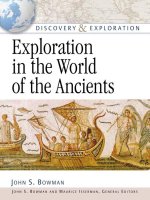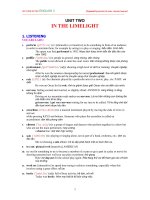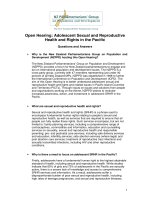CRUDE OIL EXPLORATION IN THE WORLD pdf
Bạn đang xem bản rút gọn của tài liệu. Xem và tải ngay bản đầy đủ của tài liệu tại đây (14.76 MB, 230 trang )
CRUDE OIL EXPLORATION
IN THE WORLD
Edited by Mohamed Abdel-Aziz Younes
Crude Oil Exploration in the World
Edited by Mohamed Abdel-Aziz Younes
Published by InTech
Janeza Trdine 9, 51000 Rijeka, Croatia
Copyright © 2012 InTech
All chapters are Open Access distributed under the Creative Commons Attribution 3.0
license, which allows users to download, copy and build upon published articles even for
commercial purposes, as long as the author and publisher are properly credited, which
ensures maximum dissemination and a wider impact of our publications. After this work
has been published by InTech, authors have the right to republish it, in whole or part, in
any publication of which they are the author, and to make other personal use of the
work. Any republication, referencing or personal use of the work must explicitly identify
the original source.
As for readers, this license allows users to download, copy and build upon published
chapters even for commercial purposes, as long as the author and publisher are properly
credited, which ensures maximum dissemination and a wider impact of our publications.
Notice
Statements and opinions expressed in the chapters are these of the individual contributors
and not necessarily those of the editors or publisher. No responsibility is accepted for the
accuracy of information contained in the published chapters. The publisher assumes no
responsibility for any damage or injury to persons or property arising out of the use of any
materials, instructions, methods or ideas contained in the book.
Publishing Process Manager Vana Persen
Technical Editor Teodora Smiljanic
Cover Designer InTech Design Team
First published March, 2012
Printed in Croatia
A free online edition of this book is available at www.intechopen.com
Additional hard copies can be obtained from
Crude Oil Exploration in the World, Edited by Mohamed Abdel-Aziz Younes
p. cm.
ISBN 978-953-51-0379-0
Contents
Preface IX
Chapter 1 Crude Oil Geochemistry Dependent
Biomarker Distributions in the Gulf of Suez, Egypt 1
M. A. Younes
Chapter 2 Hydrocarbon Potentials
in the Northern Western Desert of Egypt 23
M. A. Younes
Chapter 3 Crude Oil and Fractional Spillages Resulting
from Exploration and Exploitation
in Niger-Delta Region of Nigeria: A Review
About the Environmental and Public Health Impact 17
John Kanayochukwu Nduka, Fabian Onyeka Obumselu
and Ngozi Lilian Umedum
Chapter 4 Magnetic Susceptibility of Petroleum
Reservoir Crude Oils in Petroleum Engineering 71
Oleksandr P. Ivakhnenko
Chapter 5 Environmental Bases on
the Exploitation of Crude Oil in Mexico 89
Dinora Vázquez-Luna
Chapter 6 Spreading and Retraction
of Spilled Crude Oil on Sea Water 107
Koichi Takamura, Nina Loahardjo, Winoto Winoto,
Jill Buckley, Norman R. Morrow, Makoto Kunieda,
Yunfeng Liang and Toshifumi Matsuoka
Chapter 7 Fate of Subsurface Migration
of Crude Oil Spill: A Review 125
P. O. Youdeowei
Chapter 8 Crude Oil Transportation:
Nigerian Niger Delta Waxy Crude 135
Elijah Taiwo, John Otolorin and Tinuade Afolabi
VI Contents
Chapter 9 Degradation of Petroleum Fractions
in Soil Under Natural Environment:
A Gravimetric and Gas Chromatographic Analysis
Prahash Chandra Sarma
Chapter 10 To what Extent Do Oil Prices Depend on the Value of US
Dollar: Theoretical Investigation and Empirical Evidence 181
Saleh Mothana Obadi
Chapter 11 A State-of-the-Art Review of Finance Research
in Physical and Financial Trading Markets in Crude Oil 203
Andrew C. Worthington
Preface
Exploring for oil and gas Traps is one of the main aim of the “Crude Oil Exploration in
the World” which represents an important part of the Treatise of Petroleum Geology
and Geochemistry in the world.
We have chosen eleven distinguished papers from the entire submitted researches
around the world in the field of oil and gas exploration and environmental application
from the world. These researches represent a guide to the petroleum geologists and
geochemists all over the world.
The handbook of “Crude Oil Exploration in the World” is a professional exploration's
guide to the petroleum technology, methodology to explore fields of oil and gas in the
world.
Prof. Dr. Mohamed Abdel-Aziz Younes
General Coordinator of Petroleum Geology Program
Professor of Petroleum Geology and Geochemistry,
Geology Department, Moharrem Beck,
Faculty of Science,
Alexandria University,
Alexandria,
Egypt
1
Crude Oil Geochemistry Dependent Biomarker
Distributions in the Gulf of Suez, Egypt
M. A. Younes
Geology Department, Moharrem Bek, Faculty of Science,
Alexandria University, Alexandria,
Egypt
1. Introduction
The Gulf of Suez occupies the northern end of the Red Sea rift (Said, 1962) Figure 1. It is a
northwest-southeast fault-forming basin that provided adequate conditions for hydrocarbon
generation, maturation and entrapment (Dolson et al., 2000). The Gulf of Suez province has
been producing oil since 1908 and is reported to have 1.35 billion barrels of recoverable oil
reserves. Intensive exploration has resulted in the discovery of more than 120 oil fields
providing more than 50% of the overall daily oil production in Egypt (Egypt Country
Analysis Briefs, 2009).
The Precambrian to Holocene lithostratigraphic succession of the Gulf reaches a total
thickness of about 6,000 meters (Figure 2), which contributed to the development of
different types of structural traps as well as different source, reservoir, and cap rocks (Khalil
and Moustafa, 1995). It can be subdivided into three major lithostratigraphic sequences
relative to the Miocene rifting of the Afro-Arabian Plate that led to the opening of the Suez
rift and deposition of significant syn-rift facies from the Miocene Gharandal and Ras Malaab
Groups (Evans, 1990). The pre-rift lithostratigraphic section, starting from the Nubia
Sandstone to the Eocene Thebes Formation, rests unconformably on Precambrian basement.
Rifting in the Gulf was associated with the upwelling of hot asthenosphere (Hammouda,
1992). Both crustal extension and tectonic subsidence reached their peaks between 19 and 15
Ma (Steckler, 1985; Steckler et al., 1988). Palaeozoic through Tertiary strata and major
Precambrian basement blocks are exposed on both sides of the southern province which is
characterized by structural and depositional complexity (Winn et al., 2001). The regional dip
of strata is towards the SW (Meshref et al., 1988).
Previous geochemical studies throughout the Gulf of Suez have revealed that the oils are
derived mainly from marine sources, which may be differentiated into three main groups
(Mostafa, 1993 and Barakat et al., 1997). The distribution of these oil families are consistent
with the geographic subdivisions of the Gulf of Suez provinces as northern, central and
southern (Moustafa, 2002). Crude oil of the northern Gulf of Suez province is characterized
by a C
35
/C
34
homohopane index <1 and a relatively heavy carbon isotope composition (
13
C
saturate -27‰) suggesting generation from a less reducing marine source rock environment
at relatively low levels of thermal maturity. Meanwhile, crude oil of the central province is
characterized by low API gravity, a predominance of pristane over phytane, a high C
35
/C
34
Crude Oil Exploration in the World
2
homohopane index, and a lighter carbon isotopic composition (
13
C saturate -29‰). oils of
the southern province is characterized by a high API gravity, a low sulfur content and
intermediate carbon isotopic composition values (
13
C saturate -28 to -29 ‰). These two oil
groups are believed to be derived from a marine source and exhibits compositional
heterogenity suggesting a complex petroleum system may be present in the Gulf of Suez
province.
In the present study saturate and aromatic biomarker distributions as well as stable carbon
isotope compositions have been determined for a collection of crude oils of various ages and
derived from different source rock types in the Gulf of Suez. These biomarker parameters
have been used in an attempt to characterize the types of organofacies, and depositional
environments, and to assess the thermal maturity of the source rocks responsible for oil
generation.
2. Sampling and analytical techniques
Crude oils of various ages and derived from various source rock types were collected from
the giant producing fields in the Gulf of Suez namely: July, Ramadan, Badri, El-Morgan,
Sidki, Ras El-Bahar, East Zeit, Hilal, Zeit Bay and Shoab Ali (Fig. 1). These oil samples were
collected from syn-rift (Miocene) and pre-rift (Palaeozoic, Lower and Upper Cretaceous)
reservoirs (Fig. 2).
The crude oil samples were fractionated using high performance liquid chromatography
(HPLC) into saturates, aromatics, and resins following the standard procedures outlined by
Peters and Moldowan (1993). Saturate fractions were treated with a molecular sieve (silicate)
to remove the n-alkanes. The saturate and aromatic fractions were analyzed on a Hewlett
Packard 5890 Series-II gas chromatograph equipped with a Quadrex 50m fused silica
capillary column. The gas chromatograph was programmed from 40
o
C to 340
o
C at 10
o
C/min with a 2 min hold at 40
o
C and a 20 min hold at 340
o
C. The saturate and aromatic
fractions were also analyzed by gas chromatography-mass spectrometry (GCMS) using a
Hewlett Packard 5971A Mass Selective Detector (MSD) to determine terpane (m/z 191) and
sterane (m/z 217) distributions. The aromatic steroid hydrocarbon fractions were analyzed to
determine mono- and triaroaromatic (m/z 253 and m/z 231) steroid hydrocarbon
distributions. Aromatic sulphur compounds were monitored to determine
dibenzothiophene (m/z 184), methyldibenzothiophenes (m/z 198), dimethyl-
dibenzothiophenes (m/z 212), methylnaphthalenes (m/z 142, 156 and 170) and phenanthrenes
(m/z 178, 192 and 206). Stable carbon isotope values (
13
C) were determined for the whole
oils, saturate and aromatic hydrocarbon fractions using a Micromass 602 D Mass-
Spectrometer. Data are reported as
13
C (‰) relative to the PDB standard. The organic
geochemical analyses and stable carbon isotopes for the studied crude oil samples were
conducted at the organic geochemical laboratories, Oklahoma State University, USA.
3. Results and discussions
Rohrback (1982) concluded that all the crude oils of the Gulf of Suez appear to be of the
same genetic family. However, great variations in the biological marker distributions and
stable carbon stable isotope compositions of the studied crude oils from this province
suggest that this group should be subdivided into two subfamilies consistent vertically with
Crude Oil Geochemistry Dependent Biomarker Distributions in the Gulf of Suez, Egypt
3
Fig. 1. Map showing the distribution of oil samples from the different fields of the southern
Gulf of Suez province.
Crude Oil Exploration in the World
4
Fig. 2. Generalized lithostratigraphic succession illustrating the rifting sequences and
hydrocarbon distributions in the southern Gulf of Suez modified after (Alsharhan, 2003).
the syn-rift and pre-rift tectonic sequences of the Gulf of Suez. Furthermore, the data from
the present study suggests two oil families represent two distinct independent petroleum
systems for hydrocarbon generation and maturation.
Crude Oil Geochemistry Dependent Biomarker Distributions in the Gulf of Suez, Egypt
5
Table 1. Bulk, biomarker properties and stable carbon isotope composition of crude oils
from the Gulf of Suez.
Crude Oil Exploration in the World
6
Peak No. Compound Name
A
B
C
D
E
F
G
G
H
I
I
J
J
K
K
L (Ts)
M (Tm)
N
N
P
P
Q
R
S
T
U
V
W
X
Y
Z
C
19
Tricyclic terpane
C
20
Tricyclic terpane
C
21
Tricyclic terpane
C
22
Tricyclic terpane
C
23
Tricyclic terpane
C
24
Tricyclic terpane
C
25
Tricyclic terpane (22R)
C
25
Tricyclic terpane (22S)
C
24
Tetracyclic terpane
C
26
Tricyclic terpane (22R)
C
26
Tricyclic terpane (22S)
C
28
Tricyclic terpane (22R)
C
28
Tricyclic terpane (22S)
C
29
Tricyclic terpane (22R)
C
29
Tricyclic terpane (22S)
C
27
18
(H)-22, 29, 30- trisnorneohopane
C
27
17
(H)-22, 29, 30- trisnorhopane
C
30
Tricyclic terpane (22R)
C
30
Tricyclic terpane (22S)
C
31
Tricyclic terpane (22R)
C
31
Tricyclic terpane (22S)
C
29
18
(H)-norneohopane ( 29Ts)
C
30
18
(H)-oleanane
C
30
17
(H), 21
(H)-hopane
C
30
17
(H), 21
(H)- moretane
C
31
17
(H), 21
(H)-30 homohopane (22S)
C
31
17
(H), 21
(H)-30 homohopane (22R)
C
30
Gammacerane
C
32
17
(H), 21
(H)-30 bishomohopane (22S)
C
32
17
(H), 21
(H)-30 bishomohopane (22R)
C
33
17
(H), 21
(H)-30 trishomohopane (22S)
C
33
17
(H), 21
(H)-30 trishomohopane (22R)
C
34
17
(H), 21
(H)-30 tetrakishomohopane (22S)
C
34
17
(H), 21
(H)-30 tetrakishomohopane (22R)
C
35
17
(H), 21
(H)-30 pentakishomohopane (22S)
C
35
17
(H), 21
(H)-30 pentakishomohopane (22R)
Table 2. Peak identifications in the m/z 191 mass fragmentograms.
Crude Oil Geochemistry Dependent Biomarker Distributions in the Gulf of Suez, Egypt
7
Peak No.
Compound Name
a
b
c
d
e
f
g
h
i
j
k
l
m
n
o
p
q
r
s
t
13β(H), 17α(H)- diacholestane (20S)
13β(H), 17α(H)- diacholestane (20R)
13α(H), 17β(H)- diacholestane (20S)
13α(H), 17β(H)- diacholestane (20R) +
24- Methyl-13β(H), 17α(H)- diacholestane (20S)
24- Methyl-13β(H), 17α(H)- diacholestane (20R)
5α(H), 14α(H), 17α(H) – cholestane (20S)
5α(H), 14β(H), 17β(H) – cholestane (20R) +
24-Ethyl-13β(H), 17α(H)- diacholestane (20S)
5α(H), 14β(H), 17β(H) – cholestane (20S) +
24-Methyl-13β (H),
17α(H)- diacholestane (20R)
5α(H), 14α(H), 17α(H) – cholestane (20R)
24-Ethyl-13β(H), 17α(H)- diacholestane (20R)
24-Ethyl-13 α(H), 17β(H)- diacholestane (20S)
5α(H), 14α(H), 17β(H)– 24-methylcholestane (20S)
5α(H), 14α(H), 17β(H)– 24-methylcholestane (20R)+
24-Ethyl-13 α(H), 17β(H)- diacholestane (20R)
5α(H), 14β(H), 17β(H)– 24-methylcholestane (20S)
24-Propyl-13α(H), 17β(H)- diacholestane (20S)
5α(H), 14α(H), 17α(H)– 24-methylcholestane (20R)
5α(H), 14α(H), 17α(H)– 24-ethylcholestane (20S)
5α(H), 14β(H), 17β(H)– 24-ethylcholestane (20R)
5α(H), 14β(H), 17β(H)–
24-ethylcholestane (20S)
5α(H), 14α(H), 17α(H)– 24-ethylcholestane (20R)
Table 3. Peak identifications in the m/z 217 mass fragmentograms.
Crude Oil Exploration in the World
8
4. Gross geochemical characteristics
The syn-rift oil produced from (Miocene) reservoirs is a naphthenic, non-waxy crude with
API gravity ranging from 27.9
o
to 34.9
o
and sulfur content between 0.78 to 0.98 wt.% (Table
1). Meanwhile, the second type, which occurs in the pre-rift lithostratigraphic units is
paraffinic and waxy with API gravity ranging from 34
o
to 44
o
and sulfur content between
1.23 and 1.39 wt.%. The stratigraphic change in gross geochemical characteristics of the
crude oils from a naphthenic to a paraffinic type is related probably to the change of source
rock types from clastics to carbonate and environment of source rock deposition (Rohrback,
1982). High sulfur oils of the second oil type is indicative of carbonate evaporate source
rocks, while the low sulfur concentrations are typical for siliciclastic source rocks (Gransch
and Posthuma, 1974). The diversity of the gross geochemical characteristics of the crude oils
is consistent vertically with a gradual change in API gravity and maturity variation (Matava
et al., 2003).
5. Source-dependent biomarker distributions
Biomarkers are compounds that characterize certain biotic sources and retain their source
information after burial in sediments (Meyers, 2003). It is used for oil-oil and oil-source rock
correlations to assess the source of organofacies, kerogen types and the degree of thermal
maturity (Philp and Gilbert, 1986; Waples and Machihara, 1991; Peters and Moldowan, 1993;
Peters and Fowler, 2002). The great variability of saturate and aromatic biomarker indices,
listed in Table 1, that enable subdivisions of the studied crude oil into two types referred as
type-I and II as illustrated in (Figure 3). The predominance of n-alkanes and acyclic
isoprenoids in the C
11
to C
35
region of the gas chromatograms is diagnostic of marine
organofacies sources (Collister et al., 2004). A predominance of
Fig. 3. Gas chromatograms of saturate and aromatic hydrocarbon fractions for
representative crude oil types I and II.
Crude Oil Geochemistry Dependent Biomarker Distributions in the Gulf of Suez, Egypt
9
Fig. 4. Relationship between isoprenoids and n-alkanes showing source and depositional
environments (Shanmugam, 1985) of the oil samples from the Gulf of Suez. All samples are
located within the mixed to marine reducing depositional environments.
Peak No. Compound Name
A
B
C
D
E
F
G
C
20
Triaromatic Sterane
C
21
Triaromatic Sterane
C
26
Triaromatic Sterane (20S)
C
26
Triaromatic Sterane (20R)+
C
27
Triaromatic Sterane (20S)
C
28
Triaromatic Sterane (20S)
C
27
Triaromatic Sterane (20R)
C
28
Triaromatic Sterane (20R)
Table 4. Peak identifications in the m/z 231 mass fragmentograms.
pristane over phytane (Pr/Ph ratio >1) and the high odd-even carbon preference index
(CPI>1) for the type-I oil is typical of crude oils generated from source facies containing
terrigenous, wax-rich components (Peters et al., 2000). Type-II oil has lower Pr/Ph ratios
(<1) and a slight even-carbon preference index (CPI<1) indicating algal/bacterial organic
detritus in the kerogen (Collister et al., 2004), typical for a marine source rock deposited
under less reducing conditions (Lijmbach, 1975). The nature of the source rock depositional
environments can be further supported from the plotting of the isoprenoid ratios Pr/n-C
17
versus Ph/n-C
18
(Shanmugam,1985). It can be seen from Fig. 4 that both of the oil types
plotted in the border region of marine-mixed organic matter with the source rocks being
deposited under less reducing conditions and receiving significant clastic input (Bakr and
Wilkes, 2002).
Crude Oil Exploration in the World
10
Peak No. Compound Name
a
b
c
d
e
f
g
h
i
j
k
l
m
5 β- C
27
Monoaromatic Sterane (20S)
dia- C
27
Monoaromatic Sterane (20S)
5 β- C
27
Monoaromatic Sterane (20R)+
dia- C
27
Monoaromatic Sterane (20R)
5 α- C
27
Monoaromatic Sterane (20S)
5 β- C
28
Monoaromatic Sterane (20S)+
dia- C
28
Monoaromatic Sterane (20S)
5 α- C
27
Monoaromatic Sterane (20R)
5 α- C
28
Monoaromatic Sterane (20S)
5 β- C
28
Monoaromatic Sterane (20R)+
dia- C
28
Monoaromatic Sterane (20R)
5 β- C
29
Monoaromatic Sterane (20S)+
dia- C
29
Monoaromatic Sterane (20S)
5 α- C
29
Monoaromatic Sterane (20S)
5 α- C
28
Monoaromatic Sterane (20R)
5 β- C
29
Monoaromatic Sterane (20R)+
dia- C
29
Monoaromatic Sterane (20R)
5 α- C
29
Monoaromatic Sterane (20R)
Table 5. Peak identifications in the m/z 253 mass fragmentograms.
Terpane biomarker distributions derived from the m/z 191 mass chromatograms are shown
in (Figure 5) and peak identifications are given in (Table 2). The ratio of Ts/(Ts+Tm) is
considered as a facies and depositional environmental parameter of the relevant source
rocks (Bakr and Wilkes, 2002). It is also considered a maturation parameter due to the
greater thermal stability of Ts (18(H)-22,29,30-trisnorneohopane) than its counterpart Tm
(17 (H)-22,29,30-trisnorhopane) (Seifert and Moldowan, 1978; Cornford et al., 1988; Isaksen,
2004). Ts/(Ts+Tm) ratio for the crude oil is generally consistent with the carbon preference
index CPI, indicating an anoxic marine depositional environment (Mello et al., 1988). The
C
35
/C
34
homohopane ratio was found to be less than unity for type-I oil, suggesting a
reducing marine environment. The Ts/(Ts+Tm) ratio is greater than unity for type-II oil
suggesting a higher contribution of bacterial biomass to the sediments possibly reflecting a
highly saline reducing environment (ten Haven et al., 1988; Mello et al., 1988).
Depositional environment biomarker parameters based on the terpanes (m/z 191), such as
the oleanane index [oleanane/(oleanane+hopane)] and gammacerane index
[gammacerane/(gammacerane+hopane)], illustrate that type-I oil is highly enriched in
oleanane compared to the type-II oil. The oleanane ratio are 28.4% in some samples clearly
demonstrating an enrichment of angiosperm higher land plant input to the source
kerogen of Tertiary age (Ekweozor et al., 1979; Moldowan et al., 1994). Meanwhile, the
low oleanane index in the type-II oil, ranging from 3.4 to 6.3%, suggesting generation
from an Upper Cretaceous source rock or older (Moldowan et al., 1994). Higher values of
the gammacerane index for type-II oil (21.7 to 25.5%) compared to type-I oil (7.6 to 9.4%)
indicates a highly saline depositional environment associated with an evaporitic-
carbonate deposition and low terrigenous input (Rohrback, 1982; Mello et al., 1988; Peters
and Moldowan, 1994).
Crude Oil Geochemistry Dependent Biomarker Distributions in the Gulf of Suez, Egypt
11
Sterane distributions for the two oil types (m/z 217) are shown in (Figures 5) and
compound identifications are given in (Table 3). The predominance of C
27
steranes (Table
1) and the presence of C
30
n-propyl steranes (Figure 5) further support the idea of
generation from bacterial-algal marine source rocks (Moldowan et al., 1985; Peters and
Moldowan, 1991). Type-II oil is highly enriched in αββ sterane isomers relative to the
type-I oil, which suggests that the type-II oil is probably generated from an evaporitic-
carbonate source rock.
Cross plots of the Pr/Ph ratio for the two oil types against various depositional
environment biomarker indices show an obvious separation of the two oil types, and a
direct relationship of the Pr/Ph ratio with the oleanane index and an inverse relationship
with gammacerane and the C
35
/C
34
homohopane ratio. An inverse relationship also exists
between the oleanane and gammacerane indices for the two oil types (Figure 6). The
separation of the two oil types is interpreted to indicate the presence of two
independently sourced oils that consistent vertically with the pre-rift and syn-rift tectonic
sequences of the Gulf of Suez.
Fig. 5. Triterpane (m/z 191) and sterane (m/z 217) distribution patterns of the saturate
hydrocarbon fractions from the two oil types in the Gulf of Suez. Labeled peaks are
identified in Tables 2 and 3.
Crude Oil Exploration in the World
12
Fig. 6. A cross plot relation of source parameter Pr/Ph ratio for the studied crude oils that
enable from differentiation of crude oils into two groups and show a direct relationship
between Pr/Ph ratio with oleanane index and reverse relation with gammacerane and
C
35
/C
34
homohopanes. A reverse relationship is shown on the basis of oleanane versus
gammacerane indices.
Fig. 7. Triaromatic (m/z 231) and monoaromatic (m/z 253) distribution patterns for two oil
types from the Gulf of Suez. Labeled peaks are identified in Tables 4 and 5.
Crude Oil Geochemistry Dependent Biomarker Distributions in the Gulf of Suez, Egypt
13
Fig. 8. Regular relationship between sterane maturity biomarkers C
29
ααα 20S/(S+R) sterane
with [(TAS/(TAS+MAS)] and C
29
αßß/(αßß + ααα).
Crude Oil Exploration in the World
14
Peak No. Compound Name
A
B
C
D
E
F
G
H
I
J
K
L
M
N
O
P
a
b
c
d
e
f
g
h
i
j
k
l
1
2
3
4
5
6
7
8
Naphthalenes
2-Methylnaphthalene
1-Methylnaphthalene
2-Ethylnaphthalene
1-Ethylnaphthalene
2,6+2,7-Dimethylnaphthalene
1,3+1,7-Dimethylnaphthalene
1,6-Dimethylnaphthalene
1,4+2,3-Dimethylnaphthalene
1,5-Dimethylnaphthalene
1,2-Dimethylnaphthalene
1,3,7-Trimethylnaphthalene
1,3,6-Trimethylnaphthalene
1,3,5+1,4,6-Trimethylnaphthalene
2,3,6-Trimethylnaphthalene
1,2,4-Trimethylnaphthalene
1,2,5-Trimethylnaphthalene
Phenanthrenes
Phenanthrene (P)
3-Methylphenanthrene
2-Methylphenanthrene
9-Methylphenanthrene
1-Methylphenanthrene
2,6+3,5-Dimethylphenanthrene
2,7-Dimethylphenanthrene
1,3+2,10+3,10+3,9-Dimethylphenanthrene
1,6-Dimethylphenanthrene
1,7-Dimethylphenanthrene
2,3-Dimethylphenanthrene
1,9-Dimethylphenanthrene
Dibenzothiophenes
Dibenzothiophene
4-Methyldibenzothiophene
3,2-Methyldibenzothiophene
1-Methyldibenzothiophene
4-Ethyldibenzothiophene
4,6-Dimethyldibenzothiophene
2,4-Dimethyldibenzothiophene
1,4-Dimethyldibenzothiophene
Table 6. Peak identifications of the aromatic sulfur compound mass fragmentograms.
Crude Oil Geochemistry Dependent Biomarker Distributions in the Gulf of Suez, Egypt
15
6. Maturation-dependent biomarker distributions
The Gulf of Suez province is characterized by local areas of higher heat flow due to the
presence of hot spots in the southernmost Gulf and northern Red Sea (Alsharhan, 2003).
Biomarker maturity parameters, including the sterane isomerization , C
29
ααα20S/(S+R),
and ratios based on the mono-and triaromatic steroidal hydrocarbon distributions (m/z 253
and 231) are shown in (Figure 7) with compound identifications in (Tables 4 and 5). These
parameters also clearly distinguish the two different oil types on the basis of their different
maturity levels consistent with the pre-rift and syn-rift tectonic sequences of the Gulf of
Suez. Increasing source rock maturation from diagenesis to catagenesis is accompanied by
an increase in the degree of aromaticity that converts monoaromatic steroids (MAS) to
triaromatic steroids (TAS) lead to an increase thermal maturity through
diagenetic/catagenetic processes results in the conversion of monoaromatic steroid to
triaromatics (Seifert and Moldowan, 1978).
The triaromatic/monoaromatic maturity parameters (TAS/MAS) for all isomers and
C
27
/C
28
ratios found to be 60% for type-I oil. For type-II B oil these ratios reaches more than
75%. Both of these ratios indicate a predominance of triaromatic relative to monoaromatic
steroids for type-II oil compared to type-I oil which in turn reflect the higher maturity level
for the type-II oil. Thus, it is proposed that type-II oil was generated from high mature
source rock compared to type-I oil which are considered to be derived from a marginally
mature source rock in the Gulf of Suez.
A plot showing the relationship between the sterane isomerization ratios C
29
ααα 20S/(S+R)
and C
29
αßß/(αßß+ααα) and TAS/(MAS+TAS), that according to Seifert and Moldowan
(1981), are genetically related to the effect of thermal maturity processes are shown in
(Figure 8). It shows that there is a direct relationship between C
29
ααα 20S/(S+R) and both
TAS/(MAS+TAS) and C
29
αßß/(αßß+ααα) increasing with burial depth of the source rocks
(Matava et al., 2003). Type-II oil has a maximum value of 0.71 for the sterane isomerization
ratio and 0.59 for the C
29
ααα 20S/(S+R) ratio, while these ratios for type-I oil is 0.53 and 0.36
respectively. The API gravity is directly proportional to the maturity biomarker parameters
as C
29
ααα 20S/(S+R), C
29
αßß/(αßß+ααα), TAS/(MAS+TAS) and C
35
/C
34
homohopanes as
shown in ( Figure 9). These relationships also support the high thermal maturity level of the
type-II oil compared to the type-I oil in the Gulf of Suez province.
Diasterane/sterane ratios are highly dependent on both the nature of the source rock and
level of thermal maturity. This ratio is commonly used to distinguish carbonate from clay
rich source rocks and can be used to differentiate immature from the highly mature oils
(Seifert and Moldowan, 1978). Type-I oil is slightly depleted in diasteranes relative to type-II
oil, probably reflecting differences in their level of thermal maturity and also differing
clastic input to their source rocks (Kennicutt et al., 1992). Aromatic sulfur compounds such
as dibenzothiophene (DBT), methyldibenzothiophenes (MDBT) and dimethyldibenzo-
thiophenes (DMDBT) can be used as maturity indicators of source rock and petroleum
(Chakhmakhchev et al., 1997; Radke et al., 1997). Figure (10) displays representative
partially expanded mass chromatograms of the aromatic sulfur hydrocarbons representing
naphthalenes, phenanthrenes and dibenzothiophenes with compound identifications given
in (Table 6). Previous studies (e.g. Radke et al., 1997) have demonstrated that the relative
distributions of methylated aromatic compounds are thermodynamically controlled and,
with increasing maturity, a decrease is observed in the amount of the less stable α-









